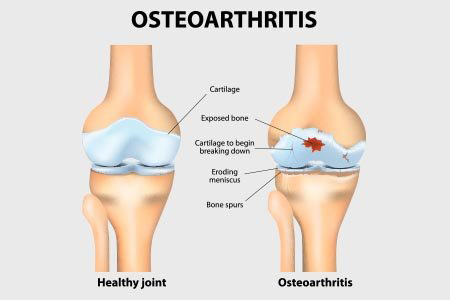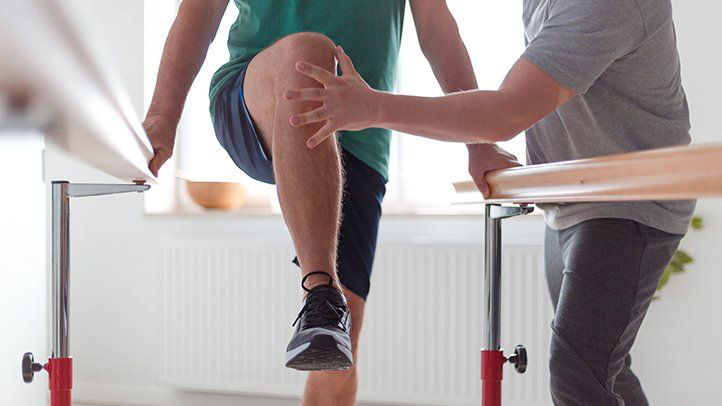Osteoarthritis is one of the most common types of arthritis and affects millions of people worldwide every year. There are more than 100 different types of osteoarthritis and related problems.
People of all races, genders, and ages can get osteoarthritis, and in many parts of the world, this disease is the principal cause of physical disability. This disease is more common among women, and the probability of its occurrence increases with age.
This disease destroys articular cartilage over time. As a result, the patient faces difficulty walking or daily activity. With cartilage damage, the bones come in direct contact with each other, causing severe pain in the patient.
This disease should not be confused with osteoporosis because, in osteoporosis, the cartilage is healthy, but the bone itself becomes weak. Therefore, bones are more likely to be fragile.

What are the types of osteoarthritis?
Primary
It commonly starts in the 50s. Genetic factors are usually involved and also affect women more than men. Primary osteoarthritis is absent in the wrists, elbows, and shoulders. Primary osteoarthritis is also seen in the lower limbs, such as the knees, fingers, hips, thumbs, spine, and big toes, but not in other joints of the lower limbs.
Secondary
It comes after a specific disease such as rheumatoid arthritis, infection, and fracture of the joint. Secondary osteoarthritis can occur in any joint, but primary osteoarthritis can only appear in certain joints. Primary osteoarthritis is important than secondary because, in secondary osteoarthritis, by controlling the underlying disease, you can significantly prevent the progression.
Degenerative
Degenerative arthritis is the most common type of disease. When the cartilage breaks down, the bone rubs against the bone, causing pain, swelling, and stiffness. Over time, the joints will weaken, and the pain will become chronic. Risk indicators include overweight, family history, age, and previous injuries. You can control it with the following tips:
- Balance activities with rest
- Use of hot and cold treatments
- Regular physical activity to maintain a healthy weight
- Strengthen the muscles around the joint
- Use of assistive devices
- Avoid repetitive heavy movements
If the joint symptoms become worse, that causes limit flexibility and lower quality of life. Some of the above solutions may work in this situation, but joint replacement will be necessary. You can prevent arthritis by staying active, maintaining a healthy weight, and avoiding injury.
Inflammatory arthritis
A healthy immune system fights infection and disease by activating internal inflammation but, the immune system can deviate and mistakenly attack the joints with uncontrollable inflammation, which leads to erosion of joints and possibly internal organs such as the eyes and other parts of the body. Rheumatoid arthritis (RA), gout, seronegative spondyloarthropathies, and ankylosing spondylitis are examples of inflammatory arthritis.
Infectious arthritis
A bacterium, virus, or fungus can enter the joint and causes to provoke inflammation. Examples of them that can infect the joint are Salmonella and Shigella, Chlamydia and Gonorrhea, and Hepatitis C. In many cases, treatment with antibiotics can clear the joint of infection but sometimes becomes chronic arthritis.
Metabolic
Some people have high levels of uric acid because their bodies naturally produce more than the usual level or, the body cannot get rid of uric acid. In some people, uric acid builds up the deposition of crystals of sodium urate in the joints, causing severe pain in the area or gout. Gout may come and go in stages, or if uric acid levels do not drop, it can become chronic and cause incurable pain and disability.
causes
- Age
- Obesity
- Heredity
- Injury
- Overuse of certain joints increases the risk of developing osteoarthritis
- Joint diseases
- knee fractures
- Diet
Symptoms
The symptoms of osteoarthritis are very different, but the main signs are pain and sometimes stiffness in the affected joints. These symptoms may be severe or mild but will get worse over time. Severe osteoarthritis can cause chronic pain, inability to daily activities, and difficulty walking. Osteoarthritis causes permanent changes in the joints. These changes can be clear such as, hard and knobbly, especially in the finger joints, or soft, caused by thickening of the joint lining and extra fluid inside the joint capsule.

Also read: What Do You Want to Know About Osteoporosis?
Treatments
The goal of osteoarthritis treatment is to control pain, minimize joint damage, maintain function, and improve quality of life. A wide range of effective medications and changing lifestyles can help to achieve this goal.
Of course, medicinal treatment is depending on the type of osteoarthritis. In most patients can be managed, and pain and disability by early detection. On the other hand, early diagnosis and treatment can prevent tissue damage caused by arthritis.
- lifestyle changes
- pain relief medications
- physical therapies
- supplements and complementary treatments.
How to prevent osteoarthritis?
Although it is impossible to prevent osteoarthritis, you can reduce the risk by following these tips:
- Weight: Have a balanced weight.
- Exercise: Strong muscles can provide better protection and support to the bones.
- Use standard equipment for workouts and try to use the right techniques and postures when sitting, standing, and lifting objects.
- Have a healthy diet A balanced and nutritious diet can help strengthen bones and muscles. (consume the healthy product for your meal)
Summary
Knowing more about health and disease can impact the quality of your life. SunExport exports the best natural Iranian Dates, such as (Mazafati Dates, Rabbi Dates, Piarom Dates, Sayer Dates, Shahani Dates, Zahedi Dates, and Dates products like Date Syrup, Date Paste, Date Cream, Date Sauce, Dates Seed Powder, Date vinegar.
For Pricing and order, please contact us.
